Urrah! – Soviet Infantry Formations in “Enemy at the Gates”
by Tom Burgess
Enemy at the Gates at last answers the question that we’ve had for over a year “how will big Soviet infantry units be treated under Version 4 ?” I like the answer and am eagerly looking forward to getting my “Strelk On” with this new book.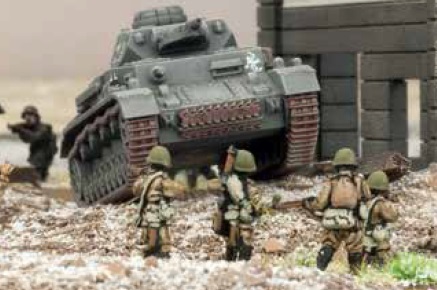
Why am I so excited? Diversity! Even before we get to Command Card options, the “Enemy at the Gates” brings the interesting Version 3 Flames of War Late War Soviet Infantry options into Version 4 Mid War.
There are two glorious Soviet Infantry Formations that allow the faithful Soviet gamer to employ no less than six Soviet Infantry Companies types: Rifle Company, Submachinegun Company, Penal Company, Hero Rifle Company, Hero Submachinegun Company, and Storm Groups.
 The first formation type, Rifle Battalion, is meant to represent the battalions from hastily raised Rifle Divisions rushed to the front in 1942 to replace the massive loss of 200 Rife Divisions in Operation Barbarossa in 1941. The 284th “Tomsk” Rifle Division is the historical representative of this type of formation. They lacked training, but with the Enemy at the Gates they made up for that with enthusiasm and numbers.
The first formation type, Rifle Battalion, is meant to represent the battalions from hastily raised Rifle Divisions rushed to the front in 1942 to replace the massive loss of 200 Rife Divisions in Operation Barbarossa in 1941. The 284th “Tomsk” Rifle Division is the historical representative of this type of formation. They lacked training, but with the Enemy at the Gates they made up for that with enthusiasm and numbers.
The Rifle Companies from these formations are the very big units that we were worried about working well under the Version 4 morale rules. The Rifle Company cost either 24 points for 28 DP MG Rifle Teams and one Komissar team or 16 points for 19 DP MG Rifle Teams and one Komissar team. These are respectively three platoon and two platoon companies. There is no option for a single platoon company like we had in previous editions of Flames of War.
The Rifle Company can be supplemented by up to two Maksim HMG teams at 1 point each, up to two PTRD ATR teams at 1 point each, one 50mm Mortar team at 1 point each, and up to two Flamethrower teams at 2 points each. One thing that a lot of former Soviet players, like myself, are not going to like is that the basing for the PTRDs and 50mm mortars has changed. These are both now mounted on large bases instead of the former medium and small bases. Each large bases would have three guns/gunners and three loaders. In the interim, I’m just going to push old bases together to make a “large base” as I’m not enthusiastic about rebasing these teams until I see what Battlefront does for Late War PTRD teams.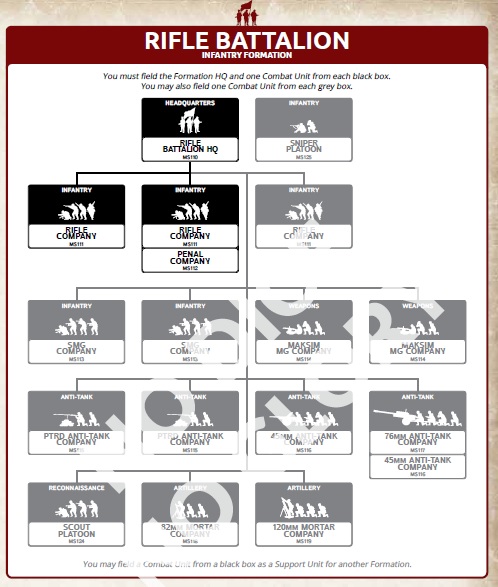
So how did Battlefront try to make these big units work in the Version 4 rules?
The Rife Companies are “Aggressive” and hit on a 3+. They are “Green” and only pass skill checks on a 5+, though are reasonable in Hand-to-Hand hitting with an Assault 4+.
The DP MG and Rifle teams have a rate of fire (ROF) of 1 stationary and moving/pinned without slow firing. I suppose the Rifle ROF is helped, even when pinned or moving, by the DP MG presence thought that’s apparently not enough to earn the stationary ROF 2 like other nations’ Rifle/MG teams.
Urrah!
The big difference is that these large units will wear down more quickly. This is due to only having a 4+ save rather than the standard infantry 3+ save. To compensate for the worse save, these units have been given the “Urrah” rule. This rule lets teams from the charging unit move 6”, rather than the normal 4”, to get in to contact during close assaults. This will aid the unit in retaining the higher required number of teams to be hit to be pinned during the assault and help bring more teams into contact. The basic idea is that these units will bleed out quickly, but if and when they do make it into contact, they will be a serious threat.
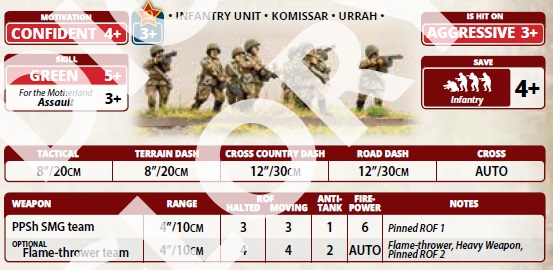 The other infantry company types available to the Rifle Battalion formation also have some unique features. The Submachinegun Company comes with 22 PPSh SMG teams and a Komissar team for 22 points or 15 PPSh SMG teams and a Komissar team for 15 points.
The other infantry company types available to the Rifle Battalion formation also have some unique features. The Submachinegun Company comes with 22 PPSh SMG teams and a Komissar team for 22 points or 15 PPSh SMG teams and a Komissar team for 15 points.
The SMG cannot add PTRDs, 50mm Mortars, and HMGs like the Rifle Company can but it can add up to Flamethrower teams at 2-points each. The Submachinegun Company also has the “Urrah” rule, but it has an even better assault rating of 3+. It’s not explicitly stated in the text of the book why the unit gets this boost but one could easily imagine it’s due to all those SMGs being used in close combat.
The infantry type the Rifle Battalion formation can take is the Penal Company. These are the well-known “rehabilitation” units that were often used as cannon fodder to give its soldiers a chance to make up for past transgression against the Party, crimes, or battlefield cowardice. This unit can be taken with 28 Rifle teams and one Komissar team at 27 points or 19 Rifle teams and one Komissar team at 18 points. The unit cannot take 50mm mortars, HMGs, PTRDs, or Flamethrowers like the normal Rifle Company can. Note that the Penal Company does have has slow firing due to the absence of the DP MGs.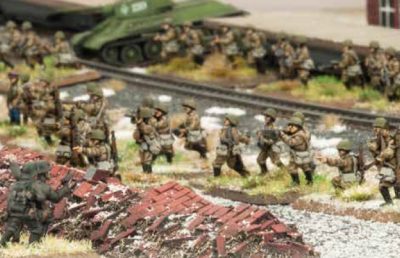
The Penal Company has the “Urrah” special rule like the Rifle Company and the SMG Company. In addition, the Penal Company also has the “Redemption” special rule. This rule helps the unit get out front by essentially giving it the “Spearhead” rule. However, the unit does not allow other units to forward deploy like a normal Spearhead would. Also, this rule cannot be used to spearhead off of another Spearhead unit’s forward deployment area.
All three company types in Rifle Battalion have the “Komissar” rule in effect while there is a Komissar in the unit. Rather than shooting one of its own teams to allow a morale check reroll (as per Ver 3), now the Kommisar simply improves the unit morale when present.
This takes the Rifle Company and SMG Company motivation from a 4+ to a 3+ and motivation of the Penal Company from a 3+ to a 2+. Note that there no longer is a Battalion Komissar option and the Company Komissars are integral and must be taken. I should also note that the Komissar is no longer pistol armed like in previous versions. This team now shoots as a DP MG and M1891 Rifle team, if it is part of a Rifle Company, or it shoots as a PPSh SMG if it is part of an SMG Company.
Heroes!
The other Soviet infantry formation option in Enemy at the Gates is the Hero Rifle Battalion. These are battle hardened but also more wary troops. The Historical example given for this type for formation are battalions from the 9th Motor Rifle Brigade that would go on win Guard designation after liberating Zhitomir and Korsun in 1944.
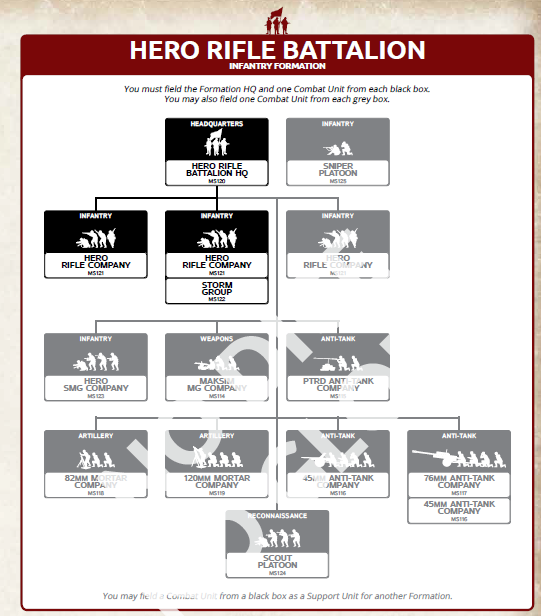 The units from the Hero Rifle battalion gain back the normal 3+ infantry save rather than having the 4+ save of the previously covered normal Rifle Battalion formation.
The units from the Hero Rifle battalion gain back the normal 3+ infantry save rather than having the 4+ save of the previously covered normal Rifle Battalion formation.
They are still green with a low 5+ skill rating, however, they hit on 4+ in assaults even though they do not have the “Urrah” rule. They are reluctant with a 5+ morale due to being survivors from bloodied formations, but so long as they have their Kommisar with them they maintain a better 4+ morale.
The Hero Rifle Company is also much smaller than the normal Rifle Companies. They come with either ten DM MG and M1891 Rifle teams with one Komissar team at 10 points or a slightly smaller seven DM MG and M1891 Rifle teams with one Komissar team at 5 points. The Hero Rifle Company can be supplemented by up to two Maksim HMG teams at 1 point each, up to two PTRD ATR teams at 1 point each, one 50mm Mortar team at 1 point, and up to one Flamethrower teams at 2 points.
The Hero Rifle Battalion must take two or three Hero Rifle Companies, but if you really want battle-hardened Soviet veterans then one of these units can be taken as a “Storm group.” This unit is meant to represent hand-picked soldiers formed into special assault units. Essentially this gives the Soviet Veteran player a nearly Fearless Veteran option. To start off, these troops are cautious and are only hit on a 4+. They are straight up Fearless with a 3+ morale, no Komissar needed here! They have the normal 3+ infantry save and thought they are only rated as Trained with a 4+ skill, they hit hard with a 2+ assault rating!
These fantastic abilities make the Storm Groups expensive in points. They also do not have the flexibility of V3 LW Sthurm Groups that they are similar to in that the options they take are the options they get with “wildcard” teams that could be changed just before a game. The Storm Group come with seven PPSh SMG teams, two Maksim HMG teams, one PTRD team, and one 50mm mortar team at 19 points. They can be also be taken as a slightly smaller unit with five PPSh SMG teams, two Maksim HMG teams, one PTRD team, and one 50mm mortar team at 16 points. The company can take an additional PTRD team at 1 point and up to two Flame-thrower teams at + 3 teams each.
The Hero Rifle Battalion can take one Hero SMG Company as a formation unit. This unit comes with either seven PPSh SMG teams and one Komissar team at 6 points or five PPSh SMG teams and one Komissar team at 4 points. The Hero SMG Company has the same stats as the Hero Rifle Company except for the better 3+ Assault Rating.
Like the normal Rifle Battalion, the Hero Rifle Battalion has some additional units that it can take. These add options for a Sniper platoon, one Maksim MG Companies, one PTRD Ant-Tank Companies, a 45mm Anti-Tank Gun Company, a second Anti-tank Company that can be 45mm or 76mm gun equipped, an 82mm Mortar Company, a 120mm Mortar Company, and a Scout Platoon.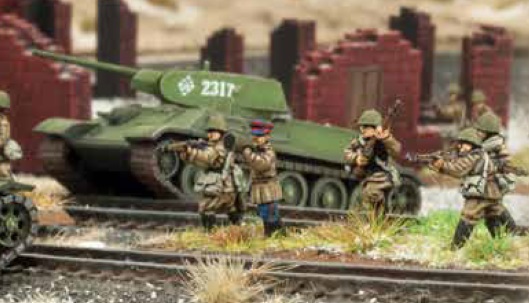
The non-infantry units that both the Rifle Battalion and Hero Rifle Battalion can take are same for both formations. Because of this, I held off on covering these until going through the six infantry company options in enemy at the gates.
One Shot, One Kill
Snipers are no longer a Battalion HQ attachment they are a separate platoon. The platoon can have one, two, or four Sniper teams at 2 points each. These operate as independent teams. They are rated as 3+ Fearless for morale but only have a 5+ Counterattack. They are rated as Trained with a 4+ Skill, but they have a tactics rating of 3+. They are aggressive and hit on a 3+ and have the normal 3+ infantry save.
Sniper rules a bit different in Version 4 now. They are always Gone-to-Ground. They are always placed in ambush in addition to other mission allowed ambushes. They can deploy from ambush in their own deployment zone or no man’s land. They are always in Good Spirits. They auto-pin any infantry, gun, or unarmored tank team they hit. And finally, they ignore mistaken target.
Snipers no longer get displaced so one they are out they are out and when they are destroyed, they are not coming back. I feel these new Sniper rules are a much simpler and more realist depiction of them on the battlefield. They are as deadly as they were but more limited in use and easier to deal with. I also think they are cheap enough now to routinely take.
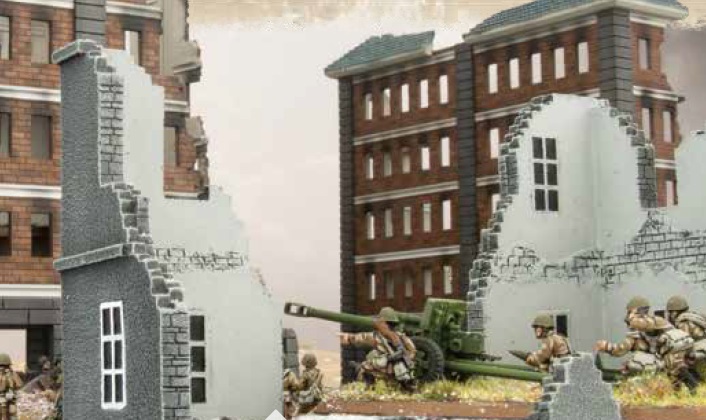 The Scout Platoon available to both the Rifle and Hero Rifle Battalions as changed a lot. First off, you now get more unit size options. These come with nine PPSh SMG teams at 13 points, seven teams at 10-points or five teams at 7 points. The teams are Careful and hit on a 4+ with the normal 3+ infantry save. They are trained, with a 4+ skill rating but have a better 3+ Tactics rating. They are Fearless with a 3+ morale, but only counterattack on a 5+. They do have the Scout and Spearhead rule.
The Scout Platoon available to both the Rifle and Hero Rifle Battalions as changed a lot. First off, you now get more unit size options. These come with nine PPSh SMG teams at 13 points, seven teams at 10-points or five teams at 7 points. The teams are Careful and hit on a 4+ with the normal 3+ infantry save. They are trained, with a 4+ skill rating but have a better 3+ Tactics rating. They are Fearless with a 3+ morale, but only counterattack on a 5+. They do have the Scout and Spearhead rule.
The PTRD, Maksim, 45mm ATGs, 76mm ATGs, 82mm Mortar and 120mm Mortar units all have the same basic stats. There are straight up Confident with 4+ Motivation. They are Aggressive and hit on 3+ and have a save appropriate to their type. They are Green with a 5+ Skill and a 6+ Assault.
The Maksim HMGs come in at twelve teams for eight points, nine teams for six points, six teams for 4-points, and three teams for 2 points. The PTRD Anti-tank Rifles come with six teams for 4 points or three teams for two points.
The 45mm Anti-Tank Gun Companies are available in the AT7 Short 45mm Guns or AT8 Long 45mm Guns. The short guns come in 6-points for four guns, or 3-points for two guns. The Long guns come in at 8-points for four, or 4-points for two. The 76mm AT Gun Companies are direct fire only. These cost 10-points for four guns or 5-points for two.
The Mortar Companies have three size options each. The 82mm mortars can be taken with nine tubes at 6-points, six tubes for 4-points, or three tubes for 2-points. The 120mm Mortars come as eight tubes at 8-points, six tubes at 6-points or two tubes at three points.
 That covers all options for the two Soviet Infantry formations in Enemy at the Gates. The above gives a tremendous amount of options even before Support options are considered.
That covers all options for the two Soviet Infantry formations in Enemy at the Gates. The above gives a tremendous amount of options even before Support options are considered.
But what’s missing? There is no mention of the 76mm Regimental Infantry Gun units and Pioneers/Sappers that I saw. Both of these could be covered by Command Cards and indeed the latter is how other Nations’ Pioneer/Sappers/Engineers have been added.
At the time of this writing, the only infantry Command Card mentioned has leaked has been some sort of Komissar/Maksim unit card that lets a Maksim unit shoot at its own troops helps get them motivated back into action. Pioneer cards as mentioned would be expected. Guards or Militia Command Cards could allow for some more stat line variation. A Smoke Pot, which were rules LW Soviet Assault Sapper units had would be an interesting option, but for now we’ll just have to wait and see.
Even before we consider what additional options Command Cards might give to the Soviet Infantry formations, I have to be impressed with the sheer volume of options available to the two Soviet Infantry formations in this book. This book finally gives an option to Mid-War Soviet infantry players. They can run the human tidal wave type forces or go with smaller more elite units.
The version four stat line variation really has lived up to its full potential with the Soviets in Enemy at the Gates allowing subtle nuances between to differentiate similar units. Even though it looks like I need to rebase my PTRDs and 50mm mortars, I am extremely excited to start putting Soviet Infantry formations to the test especially in the new City Fighting Scenarios. Traditional Soviet Infantry players have a lot to look forward to in Enemy at the Gates.
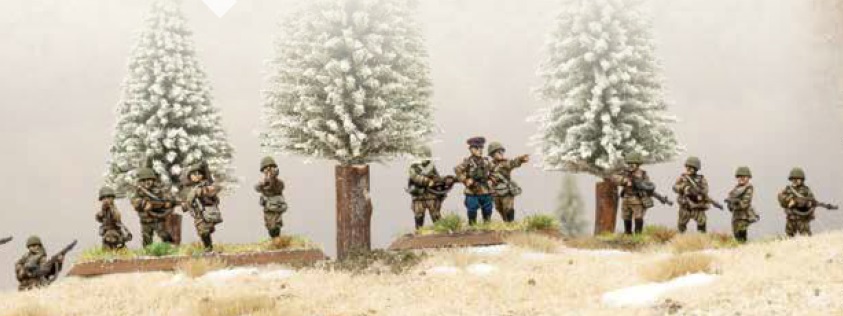

“The Rifle Company cost either 24 points for 28 DP MG Rifle Teams and one Komissar team or 16 points for 28 DP MG Rifle Teams and one Komissar team. ”
Looks like a an error in # of teams for 2nd option .
Bad copy/paste no doubt, Will fix it. Thanks.
The Russians were a blast to play! They can aptly be considered a “Swiss Army Knife” because of all the options that they can bring. Wonderful either assaulting or defending!
I had just bought a bunch of PTRD a/t rifles and had about half of them painted when V4 came out so now I’m ready to re-do them for this book!
The 50mm mortar does not fire a bombardment but it does have the capability to shoot over friendly troops.
Urrah!
What changed with the ptrd basing?
Now on large bases with 3 guns/loader per base.
excellent review; sounds like Soviet Infantry is back with a fighting chance
What is the cost for the Anti-tank Rifle company?
PTRD teams were interspersed with the riflemen. A great depiction of their deployment is in the film “28”, made by Russians for Russians.